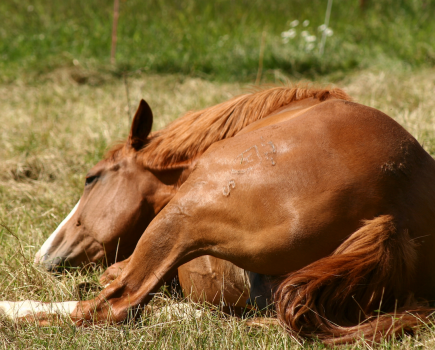Every horse will benefit from having a soaked feed in their diet, especially in the winter, and there are plenty on the market to choose from, including Fast Fibre Horse Feed by Allen & Page.
A soaked feed is designed to be mixed with water before it is fed to a horse, making it a brilliant way of increasing an equine’s water intake and boosting their hydration levels all year round.
The equine market has come a long way since adding water to hard feed meant soaking sugar beet shreds or whipping up a bran mash — there is a vast range now, many of which I will discuss below.
Providing water is one of the golden rules of feeding a horse, and I personally always give a soaked feed to my own equines or, at the very least, mix their hard feed with plenty of water. I have done this for years and believe this is partly why I have had very few instances of colic on my yard.
When you consider that every adult horse is made up of between 65-75% water, it’s easier to understand why water is so essential to gut health.
Providing a soaked feed can help to keep awful health problems like colic and choke at bay. Water is required for every process in the horse’s body, so don’t underestimate how big a part it plays in keeping them fit and healthy.
Fast Fibre Horse Feed
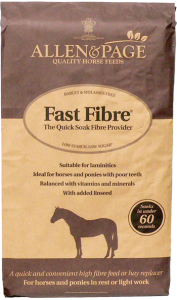
According to its manufacturer, this is a low-calorie feed that is ideal for feeding to horses and ponies who hold their weight well or who become excitable even when fed a low-energy feed. Fast Fibre Horse Feed is ready to be fed in under a minute.
Simply pour it to a bucket and add twice as much water (so, for example, if you put 1 scoop of dry feed in you then need to add two scoops of water). Stir well. Wait for 60 seconds before giving to a horse. The soaking process is clearly explained on the feedbag, so make sure you read and follow these instructions.
Fast Fibre Horse Feed is balanced with vitamins and minerals, and contains prebiotics to aid digestion plus linseed, which is a good source of Omega 3. It has a combined starch and sugar level of just 7.5% and is high in fibre — 26%.
This makes it suitable for feeding to equines at rest or in light work, those prone to laminitis, older horses with poor teeth that makes chewing difficult, and horses with intolerances to barley, alfalfa and/or molasses.
Soaking time: 60 seconds
Find out more about the Allen & Page range of horse feeds
Dengie Alfa-Beet
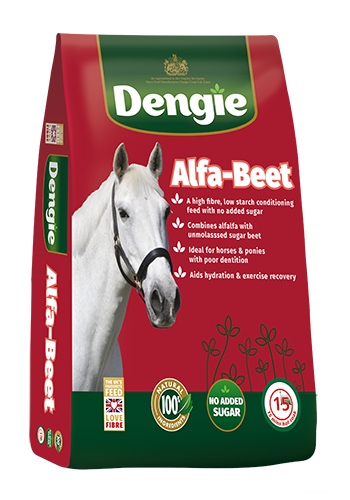
I always have a bag of this feed in my feed bin. The first equine I gave it to was my elderly first pony, Prudence, who started struggling to chew as she approached her thirties, and she loved eating this mash — especially when I gave it to her warm.
Alfa-Beet is a high-fibre feed that combines alfalfa and unmolassed sugar beet, making it ideal for horses who need to gain weight and condition while aiding hydration.
According to Dengie, Alfa-Beet provides ‘slow-release’ energy in the form of highly digestible fibre. It provides 10.5MJ/kg of Digestible Energy, which makes it comparable to a cool mix, but with much lower levels of starch.
Most recently I fed this to my ex-racehorse King, who was really struggling to hold his weight one winter but as I soon as I increased his hard feed he had too much energy when being ridden.
I emailed Dengie and a nutritionist suggested Alfa-Beet due to its low levels of starch. It transformed King.
It takes a little longer to soak Alfa-Beet than the Fast Fibre Horse Feed — 15 minutes when mixed with hot water and two hours when cold water is used — but I find this easy to work around.
My usual routine is to soak it the evening before. I like to feed it on the sloppy side, so I add a bit more water at feed time too.
Alfa-Beet can be fed as a partial hay replacer or even a total hay replacer, which may be necessary in very old horses with few teeth, when used alongside another fibre feed. More is explained about this on Dengie’s website.
Soaking time: 15 minutes (hot water) or 2 hours (cold water)
Find out more about Alfa-Beet
Spillers Speedy-Mash Fibre
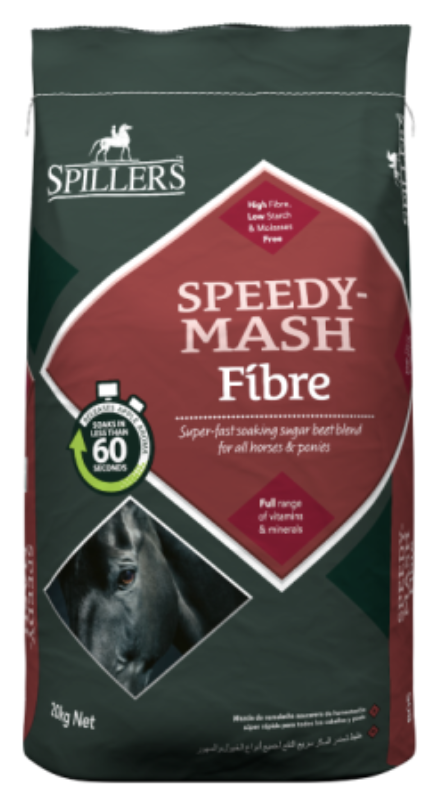
When dry, Speedy-Mash Fibre is in pellet form and it turns into a mash in 60 seconds, releasing a tasty apple aroma at the same time. According to Spillers, this mash helps to maintain topline and muscle tone, because it provides quality protein in the horse’s diet.
It is also high in fibre and low in sugar and starch, all of which means it is suitable for any equines who are overweight or are good doers and so are on a calorie-restricted diet.
Speedy-Mash Fibre also contains prebiotic FOS and probiotic live yeast to help support optimum digestive health, plus it has a full range of vitamins and minerals, such as chelated zinc and copper to help maximise absorption.
As with the other soaked feeds I have discussed so far, it is easy to eat for horses with poor or missing teeth. In fact, Spillers also makes a senior version of this Speedy-Mash specifically for older horses and ponies.
Soaking time: 60 seconds
Find out more about Speedy-Mash Fibre
TopSpec’s Linseed Mash

TopSpec describes its Linseed Mash as combining “the best of traditional knowledge with modern technology”. It is a blend of ingredients that help to add condition, with just 11% starch.
Emphasis on linseed provides significant amounts of intracellular oil and protein, including muco-polysaccharides. High levels of fibre are provided oatbran, which is said to be sympathetic to a horse’s digestive system.
The flaked maize and peas content of Linseed Mash means it looks a little different to other soaked horse feeds because it has more of a mix-like appearance.
It takes five minutes to soak at a feed/water ratio of 1:1 (ie, equal amounts of feed and warm or cold water mixed together).
“One of the ways Linseed Mash is superior to most straights is that it is supplemented with three major minerals: calcium, sodium and magnesium,” adds TopSpec.
However, it is important to note that it isn’t a complete feed. Linseed Mash doesn’t contain any added vitamins or trace elements and is designed to be fed alongside a feed balancer to ensure your horse doesn’t miss out on any vital nutritional elements.
It can also be mixed with any other chaff or horse feed.
Soaking time: 5 minutes
Find out more about Linseed Mash
Baileys’ Keep Calm Mash

A common theme with different brands of soaked horse feeds is that they are well suited to older horses who find a soft mash easier to chew than other sources of long fibre, such as hay and chaff.
This is also the case with Baileys’ Keep Calm Mash, which is targeted at the following types of horses as well:
- Horses at rest or in light to moderate work, who need help to maintain condition and a level head.
- Equines in need of a low-starch, low-sugar diet that is high in fibre (overweight horses and those prone to laminitis, for example).
- Fussy eaters.
Keep Calm Mash is a fully balanced feed, which means it can be fed on its own. A combination of beet pulp and soya hulls provides easily digestible super-fibres, which is good for the equine gut, and its overall starch and sugar levels are low (7% and less than 5% respectively).
This mash also contains prebiotic and antioxidants like vitamin E, for optimum gut heath and digestive support. It is barley-free, low in molasses and includes linseed which is high in Omega 3 fatty acids for coat shine. It provides horses with non-heating energy that maintains condition without making them too hot to handle.
Instructions are to soak Keep Calm Mash two scoops of water per one scoop of dry mash for 10 minutes in cold water before it is ready to feed.
Soaking time: 10 minutes (cold water)
Find out more about Keep Calm Mash
Mole Valley Farmers’ Quick Soak Fibre
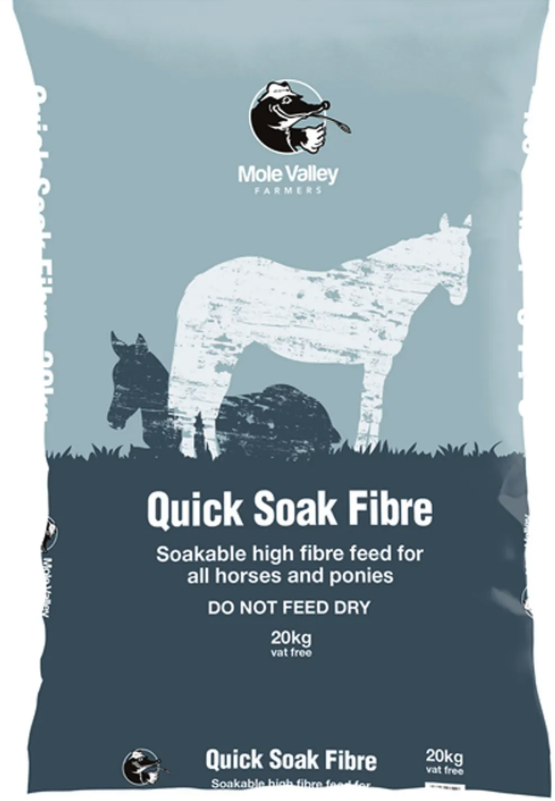
There isn’t a lot of information online about this one online, but I know it is a high-fibre soaked feed and costs £13.50 for a 20kg bag (and the price drops the more you buy).
Quick Soak Fibre has a balanced supply of vitamins and minerals to support equine health and wellbeing. It also contains unmolassed sugarbeet.
The key is that is a feed that must be soaked with water before it can be safely fed to horses, so it is a great way to boost their water intake and support hydration.
Find out more about Quick Soak Fibre
Keyflow’s Pink Mash
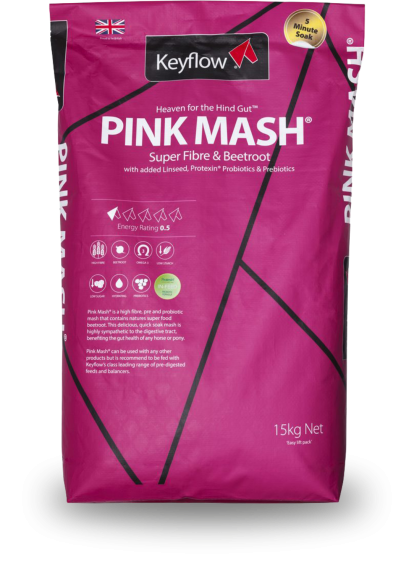
Keyflow describes its Pink Mash as “heaven for the hindgut”. It contains beetroot and linseed, which provide natural antioxidants and good quality Omega 3 in a horse’s diet. Its pro- and prebiotics help to support (and increase) the number of ‘good’ bacteria in the horse’s gut.
As well as being non-heating and high palatable, Pink Mash is a highly digestible fibre source making it ideal for older horses who require a partial hay replacer, horses prone to gastric ulcers, colic, loose droppings, plus older horses and any who are good doers.
“Pink Mash was created to restore the natural, healthy functioning of the horse’s gut, despite the environmental challenges that can often occur,” says Keyflow.
Instructions are not to mix this mash with boiling water, as thay may harm its live products. Cold water is recommended, after which it is ready to feed in two hours.
Soaking time: 2 hours
Find out more about Pink Mash
Speedi-Beet from British Horse Feeds

Speedi-Beet is 95% sugar free and is ready to feed after soaking for 10 minutes. It includes a high level of soluble fibre, mostly pectins, which makes it easy to digest and a great source of non-heating slow-release energy. Being starch-free and just 5% sugar also means it is suitable for laminitics.
This is a versatile soaked horse feed. It can be given to overweight horses or good doers in small amounts to provide multivitamins and minerals, or in larger quantities for a horse or pony lacking condition and/or working hard and in need of an energy boost.
Soaking instructions are one part dry Speedi-Beet to five parts water by weight (so, for example, one scoop of dry Speedi-Beet would require five scoops of water to soak). Add more water for a sloppier mash. It can be soaked in advance, but British Horse Feeds advise feeding within 24 hours of soaking.
Soaking time: 10 minutes
Find out more about Speedi-Beet
Dodson & Horrell’s KwikBeet

KwikBeet is made up of quick-soaking unmolassed sugarbeet flakes. It is high in fibre and naturally low in sugar (5%), and ready to be fed after soaking for 10 minutes. According to D&H, it is suitable for laminitics and can be used as partial forage replacement for older equines struggling to chew.
“Adding KwikBeet to feed ensures fluid intake for horses who drink less in times of stress, such as while travelling or competing away from home,” says D&H. “Fibre encourages motility of the gut.”
Recommended feeding levels are a maximum of 600g per 100kg of a horse’s bodyweight, split over at least two or three feeds each day, alongside ad lib forage. For every 100g of dry KwikBeet, 500ml of water should be added for soaking.
Soaking time: 10 minutes
Find out more about KwikBeet
Re-Covery Mash from Saracen Horse Feeds
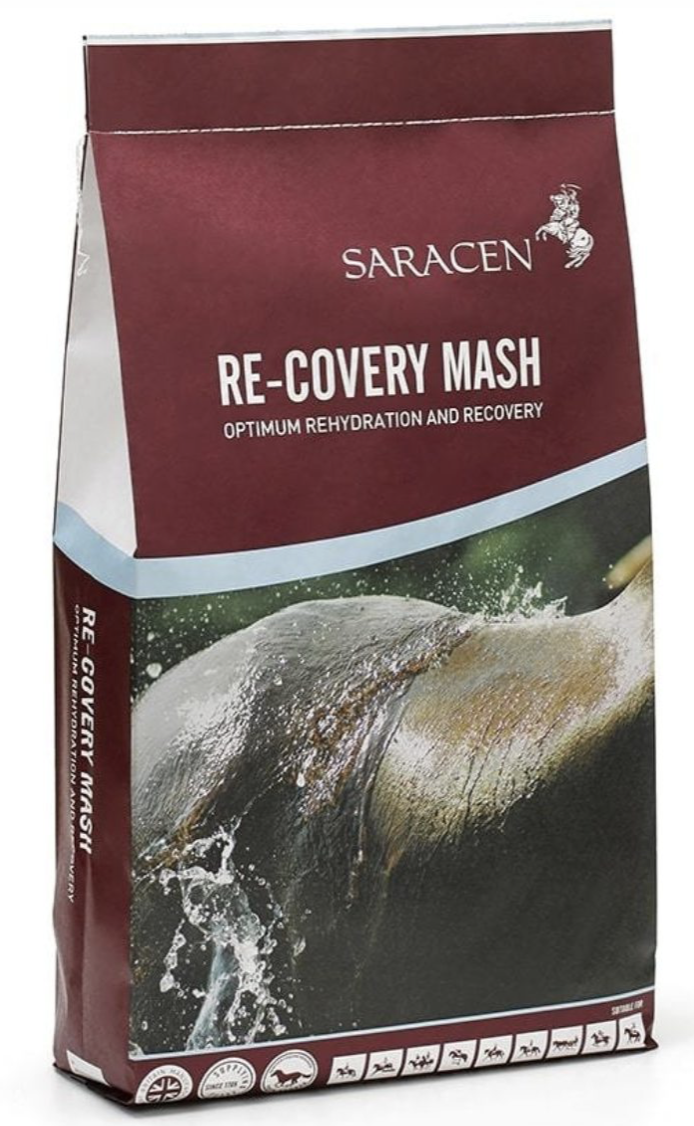
This is described by Saracen as a ‘rehydration’ mash, particularly suitable for horses after competing or working hard, those who are sick or recovering from illness, and any who need to drink more water.
Re-Covery Mash is based on ‘super fibres’ and low in starch and sugar to support gut health.
Live yeast supports the gut, while vitamin E supports the immune system as well as muscle function and recovery. It is banana flavoured to appeal to fussy feeders. It includes electrolytes for optimum hydration.
Re-Covery Mash is not designed to be fed alone, but as part of a balanced diet for optimum equine health. It soaks in warm water for three minutes or cold water for five minutes. Refer to the instructions on the feed bag for how much water is required.
Soaking time: 3 minutes (warm water) or 5 minutes (cold water)
Find out more about Re-Covery Mash
Why you should provide a soaked feed
It is imperative that any of the feeds discussed in this article are never fed to a horse dry. You should always follow the soaking instructions on the feed bag too.
Including a soaked feed like Fast Fibre Horse Feed or any of the above products is an easy and effective way to add water to your horse’s diet and boost hydration. This is so important for gut health and, in fact, good health in general.
I have had numerous point-to-pointers and hunt horses on my yard over the years and I’m sure that having a soaked feed in their diet played a key role in helping them recover.
Due to wet ground, they were always stabled overnight in winter, and I know that a hydrating feed — alongside ad lib forage fed from the floor — helped to keep their guts healthy when movement was restricted, which helped to prevent colic.
Two of my ponies who lived into their thirties — one of whom was a good doer prone to laminitis — enjoyed a soakable feed too. These are very versatile products.
Boosting hydration is my main motivation for feeding one, so it’s interesting to know how many other positive benefits they offer too. We’ve come a long way since a soaked horse feed meant adding soaked sugar beet to the bucket!
My top tip is to have a towel handy for wiping the tops of stable doors and mucky (but happy) muzzles after feed time.
The sloppier the mash — the messier it gets!
Main image © Shutterstock





